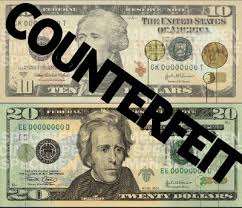counterfeit
英 [ˈkaʊn.tə.fɪt]
美 [ˈkaʊn.t̬ɚ.fɪt]
- vt. 伪造,仿造;假装,伪装
- vi. 仿造;假装
- n. 赝品;冒牌货;伪造品
- adj. 假冒的,伪造的;虚伪的
使用频率:

记忆方法
记忆“counterfeit”的方法是将它拆分成两个部分:“counter”和“feit”。联想“counter”代表“相反”或“对立”,而“feit”可以看作是“make”的过去式,意味着“制作”或“伪造”。这样,组合起来就可以理解为“制作出相反的东西”,即“伪造”或“仿造”。
以上内容由AI生成, 仅供参考和借鉴
中文词源
counterfeit 伪造
counter-, 相对。-feit, 同fact, 做。
英语词源
- counterfeit (v.)
- late 13c., from Old French contrefait "imitated" (Modern French contrefait), past participle of contrefaire "imitate," from contre- "against" (see contra-) + faire "to make, to do" (from Latin facere; see factitious). Medieval Latin contrafactio meant "setting in opposition or contrast." Related: Counterfeited; counterfeiting. The noun and adjective are from late 14c.
权威例句
- 1. All the bills had the same serial number. The cash was counterfeit.
- 所有钞票的序列号都是一样的。这些钱是伪钞。
- 2. Are you aware these notes are counterfeit?
- 你觉察到这些钞票是伪造的吗?
- 3. This coin is a counterfeit.
- 这个硬币是伪造的.
- 4. It is against the law to counterfeit money.
- 伪造货币是违法的.
- 5. 'Did you ever see a counterfeit of timidity, Mr. Lorry?'
- “ 你看见过假装胆小怕事的么, 罗瑞先生? ”